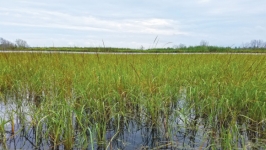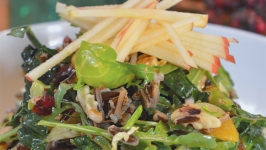A Gift from the Earth
UWGB, DUCKS UNLIMITED PARTNERING TO BRING BACK WILD RICE
Amy Carrozzino-Lyon spends much of her workday on the water. As the Green Bay restoration project coordinator, she oversees a program aimed at enhancing fish and wildlife habitat in Green Bay’s wetlands.
The University of Wisconsin-Green Bay has partnered with Ducks Unlimited in the effort that includes replanting of wild rice beds.
“Our project runs from the lower area of Green Bay up to Marinette,” said Corrozzino-Lyon. “A number of sites are on the Peshtigo river.”
Historical records and accounts from early explorers mention the presence of wild rice in Northeastern Wisconsin. As Corrozzino-Lyon explains, “Wild rice was an important part of the eco-system. We have spent the last few decades seeing that wild rice is not very present in the area any more.”
A SPECIAL GIFT
Wild rice is often referred to by Native Americans as “a gift from the earth.”
The historic ties of wild rice to Native American cultures are strong. The Great Lakes and its tributary rivers drew various Native American tribes to Wisconsin and Minnesota through a prophecy that encouraged them to “go where the food grows in the water.”
Ironically, wild rice is not a rice at all. The plant is actually an annual aquatic reed-like grass found in marshy areas of fresh water. Harvested for its seed, wild rice holds the title of the only cereal grain native to North America.
The traditional method of harvesting wild rice has not changed much through the centuries. Canoes, maneuvered by two individuals, travel through the marsh of wild rice plants. While one harvester steers the canoe like a gondola, the other uses poles, known as knockers, to gently brush the grass and dislodge the mature wild rice kernels into the canoe. Some seeds fall into the muddy water’s bottom to germinate the marsh area for the next year’s harvest. Tribal laws require that wild rice must be harvested in the traditional canoe method and even have specifications on the size of the harvesting sticks.
Just-harvested wild rice has a high water content. Traditionally the rice is dried out on birch bark or blankets and allowed to sun dry. Another drying method is to place the rice on drying racks made of green branches and parch them over an open fire. This method not only dries the rice, but also adds an additional layer of earthy smoked flavor to the finished kernels.


Planting wild rice seed. Contributed photos
AN ECO-FRIENDLY GRAIN
Those wild rice beds also play a vital part in our eco-system. “Wild rice is a very important food for waterfowl. It is an especially important food source for the fall migration, when the waterfowl is preparing to travel significant distances for the winter,” said Carrozzino-Lyon. Changes in environmental conditions have impacted the ability of the annual plant to seed each year. The project of reseeding designated waterways began in 2016 with a few selected sites. The first larger seeding began in 2017.
Corrozzino-Lyon explained, “We hand-seed in early November so the seed can winter in the sediment. It needs to be cold-hardened to germinate for the spring. Our seed is sourced from wild populations in Minnesota.”
According to Carrozzino-Lyon, the group is learning as they go.
“Although it is early, we monitor extensively during the summer season.” she explained. “This first year we are seeing a fairly good response. We are also actively collecting environmental information and seeing where the rice is growing particularly well.”
The project has two more years, so seeding will continue in 2018 and 2019 with adjustments made based on the team’s findings. Through this adoptive management approach, Carrozzino-Lyon and her team hope to bring this treasured “gift of the earth” back to the waters of Green Bay.
THE MANY BENEFITS OF WILD RICE
Wild rice is a treasured ingredient in cooking. It’s rich in iron, calcium, magnesium and zinc as well as high in fiber. On top of that, it’s gluten-free.
TYPES OF WILD RICE
True wild rice is harvested from plants that thrive in the marshy shores of lakes and rivers, mostly found in Minnesota, Wisconsin and Canada. The rice is hand-harvested by a two-man team navigating the waters in a canoe.
Most wild rice available today is not wild at all, but grown in manmade paddies that are then machine harvested. Marketed as cultivated wild rice, the kernels are darker, almost black in color and tend to be a bit chewier than wild rice grown naturally. Cultivated wild rice also lacks some of the traditional rice’s earthy flavor.
However, it is less costly and more widely available. In addition to a flavor difference, the cooking times of the rice vary. Cultivated rice will take between 50 to 60 minutes of simmering to cook, while traditional hand-harvested wild rice takes only 25 to 30 minutes.
The USDA does not have a standard grading system for wild rice, although some wild rice producers do label the various sizes of the grain. Giant or long grain wild rice is usually 1 inch in length. Fancy or medium-grain rice has a shorter length of ½-inch to ¾-inch. Select or short-grain wild rice is smaller in both width and length and may include a mixture of broken and unbroken pieces. Select wild rice is a good choice for soups where the rice size is less noticeable.
WILD RICE MATH
Wild rice is more expensive than white or brown rice, but luckily expands when cooking. A good rule of thumb when preparing wild rice is the 1-to- 4 ratio method. One part wild rice rice will expand approximately 4 times when cooked. That one cup of uncooked wild rice turns into a hearty batch of 4 cups of cooked rice.
BUYING AND STORING
Uncooked wild rice keeps for a year in a dry, airtight container in the pantry. Cultivated wild rice is available in most grocery stores. The more expensive Native American harvested wild rice is often sold in bulk to lower the cost. If you happen to be traveling in the northern part of Wisconsin, the Upper Peninsula of Michigan or any part of Minnesota, you will most likely find wild rice available for purchase in grocery stores, souvenir shops and even gas stations.
Think you can just hop in your canoe and do your own hand-harvesting? Think again. Both Minnesota and Wisconsin allow individuals other than Native Americans to harvest wild rice, but there are age limitations and you must be a state resident. You also need a license, which can be obtained through each state’s Department of Natural Resources. Check with your local DNR office for licensing specifics before hitting the water.









